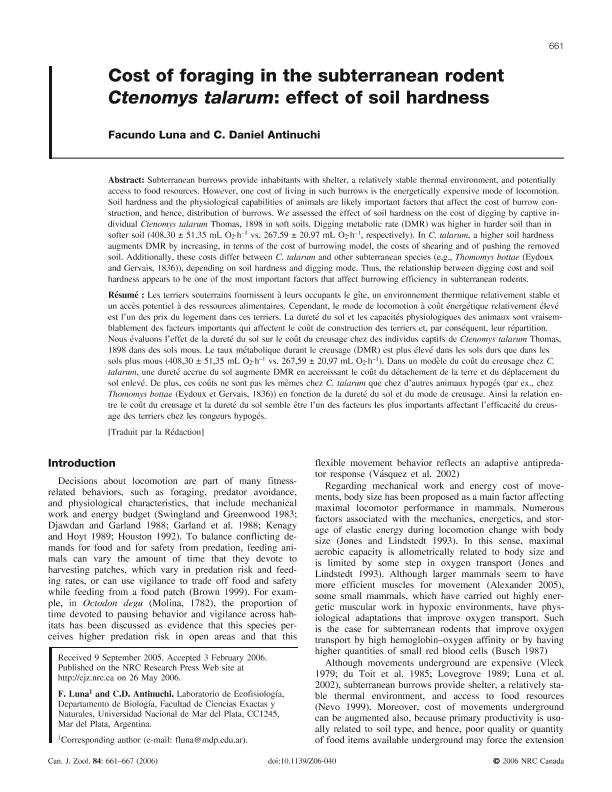Mostrar el registro sencillo del ítem
dc.contributor.author
Luna, Facundo

dc.contributor.author
Antenucci, Carlos Daniel

dc.date.available
2022-04-29T18:10:10Z
dc.date.issued
2006-05-26
dc.identifier.citation
Luna, Facundo; Antenucci, Carlos Daniel; Cost of foraging in the subterranean rodent Ctenomys talarum: effect of soil hardness; National Research Council Canada-NRC Research Press; Canadian Journal of Zoology; 84; 5; 26-5-2006; 661-667
dc.identifier.issn
0008-4301
dc.identifier.uri
http://hdl.handle.net/11336/156148
dc.description.abstract
Subterranean burrows provide inhabitants with shelter, a relatively stable thermal environment, and potentially access to food resources. However, one cost of living in such burrows is the energetically expensive mode of locomotion. Soil hardness and the physiological capabilities of animals are likely important factors that affect the cost of burrow construction, and hence, distribution of burrows. We assessed the effect of soil hardness on the cost of digging by captive individual Ctenomys talarum Thomas, 1898 in soft soils. Digging metabolic rate (DMR) was higher in harder soil than in softer soil (408.30 ± 51.35 mL O2·h–1 vs. 267.59 ± 20.97 mL O2·h–1, respectively). In C. talarum, a higher soil hardness augments DMR by increasing, in terms of the cost of burrowing model, the costs of shearing and of pushing the removed soil. Additionally, these costs differ between C. talarum and other subterranean species (e.g., Thomomys bottae (Eydoux and Gervais, 1836)), depending on soil hardness and digging mode. Thus, the relationship between digging cost and soil hardness appears to be one of the most important factors that affect burrowing efficiency in subterranean rodents.
dc.description.abstract
Les terriers souterrains fournissent à leurs occupants le gîte, un environnement thermique relativement stable et un accès potentiel à des ressources alimentaires. Cependant, le mode de locomotion à coût énergétique relativement élevé est l’un des prix du logement dans ces terriers. La dureté du sol et les capacités physiologiques des animaux sont vraisemblablement des facteurs importants qui affectent le coût de construction des terriers et, par conséquent, leur répartition. Nous évaluons l’effet de la dureté du sol sur le coût du creusage chez des individus captifs de Ctenomys talarum Thomas, 1898 dans des sols mous. Le taux métabolique durant le creusage (DMR) est plus élevé dans les sols durs que dans les sols plus mous (408,30 ± 51,35 mL O2·h–1 vs. 267,59 ± 20,97 mL O2·h–1). Dans un modèle du coût du creusage chez C. talarum, une dureté accrue du sol augmente DMR en accroissant le coût du détachement de la terre et du déplacement du sol enlevé. De plus, ces coûts ne sont pas les mêmes chez C. talarum que chez d’autres animaux hypogés (par ex., chez Thomomys bottae (Eydoux et Gervais, 1836)) en fonction de la dureté du sol et du mode de creusage. Ainsi la relation entre le coût du creusage et la dureté du sol semble être l’un des facteurs les plus importants affectant l’efficacité du creusage des terriers chez les rongeurs hypogés.
dc.format
application/pdf
dc.language.iso
eng
dc.publisher
National Research Council Canada-NRC Research Press

dc.rights
info:eu-repo/semantics/openAccess
dc.rights.uri
https://creativecommons.org/licenses/by-nc-sa/2.5/ar/
dc.subject
subterranean
dc.subject
talarum
dc.subject.classification
Otros Tópicos Biológicos

dc.subject.classification
Ciencias Biológicas

dc.subject.classification
CIENCIAS NATURALES Y EXACTAS

dc.title
Cost of foraging in the subterranean rodent Ctenomys talarum: effect of soil hardness
dc.type
info:eu-repo/semantics/article
dc.type
info:ar-repo/semantics/artículo
dc.type
info:eu-repo/semantics/publishedVersion
dc.date.updated
2021-12-03T19:59:58Z
dc.journal.volume
84
dc.journal.number
5
dc.journal.pagination
661-667
dc.journal.pais
Canadá

dc.journal.ciudad
Otawa
dc.description.fil
Fil: Luna, Facundo. Consejo Nacional de Investigaciones Científicas y Técnicas. Centro Científico Tecnológico Conicet - Mar del Plata. Instituto de Investigaciones Marinas y Costeras. Universidad Nacional de Mar del Plata. Facultad de Ciencias Exactas y Naturales. Instituto de Investigaciones Marinas y Costeras; Argentina
dc.description.fil
Fil: Antenucci, Carlos Daniel. Consejo Nacional de Investigaciones Científicas y Técnicas. Centro Científico Tecnológico Conicet - Mar del Plata. Instituto de Investigaciones Marinas y Costeras. Universidad Nacional de Mar del Plata. Facultad de Ciencias Exactas y Naturales. Instituto de Investigaciones Marinas y Costeras; Argentina
dc.journal.title
Canadian Journal of Zoology

dc.relation.alternativeid
info:eu-repo/semantics/altIdentifier/url/https://cdnsciencepub.com/doi/10.1139/z06-040
dc.relation.alternativeid
info:eu-repo/semantics/altIdentifier/doi/https://doi.org/10.1139/z06-040
Archivos asociados
